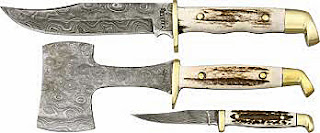Born in 1854, Webster L. Marble grew up learning
hunting, fishing and trapping skills. During his early adult life, Marble worked
as a timber surveyor and cruiser. These experiences may not have been important
except for the effect they would have upon the knives we used and trusted years
ago, knives that have become highly regarded collectibles today. Marble
recognized certain needs and used his talents to fill them. His earliest
contributions were the waterproof matchbox and safety pocket axe. Marble made
these items part-time until 1898, when he built a sixty-four square foot
building for his growing business.
Operating as W. L. Marble, Gladstone, Michigan,
he started full time manufacturing and national advertising in 1899. That year,
a partner, Frank H. Van Cleve, joined him in the business. A move was made into
a 9,000 square-foot building and in 1902; the company name was changes to “The
Marble Safety Axe Company.”
Marble’s first knife was introduced in 1900.
Named “The Idea,” this knife became the basic model from which later models
were developed. Other sheath knives, such as the “Dall DeWeese” and “Woodcraft”
models, furthered a quality image for the company. The Marble’s Safety Hunting
Knife, patented in 1902 and introduced in 1903, was deserving of the success it
achieved. Combining features of the safety axe with a quality hunting or
sporting blade, this knife is one of today’s choice collectibles. For about a
five-year period, beginning in 1903, the company marketed a line of contract
made pocketknives marked “M.S.A. Co./Gladstone/Mich. USA.” Case Brothers and
some advertisement show knives, also of high quality, made these knives, for
Marbles with ”XX” on the blade. A few other models were probably of German
manufacture. All are extremely rare, and counterfeits far outnumber originals. Beware!!
In 1911, the company name changed again, this
time to The Marble Arms and Manufacturing Company, and another move was made
into even larger quarters. Marble’s knives were so respected that Teddy
Roosevelt, the Perry Arctic Expedition, and the Smithsonian Institute
Expeditions used them. It was about this time that the knife tang stamping
changed to “MARBLES / GLASDSTONE / MICH. USA.”
Many of Marble’s patents expired during the
1920’s and other manufactures began to capitalize upon his design. Their
quality was usually lower, but so were the prices and the competition began to
take its toll on the Marble’s company. His company’s business was still quite
good when Webster Marble died in 1930. By the end of World War II, however
Marble’s sales volume and profits were declining. The axe and folding knife
line was dropped during the war and sheath knife patterns were cut to four
models. Manufacture of the axe line was revived in 1954 and remained in
production for a few years. The company began adding new sheath knife patterns,
such as the “Sportsman,” in 1954 and the number of models or variations grew to
ten during the mid 1960’s. The year 1979 saw the end of the company’s knife
manufacturing.
Marble sheath and folding knives are listed by
model, stampings, and handle variations. Several are unique and rare and a good
example of a highly prized Marble product is the Coquina Outfit sold during the
company’s early days. Named in honor of editor G. O. Shields (Coquina), the
outfit’s unique feature is its fancy sheath that holds two knives and sharpening
steel. The purchaser could choose the handle variations of an Ideal at a
regular price ranging from $2.25 to $3.50, a Skinning model knife at $1.50 and
a stag or leather handled steel at $1.00. With these purchases, the sheath was
free; it was for sale without knives or steel at $1.00. Today, a Coquina Outfit
in near mint condition is valued over $10,000.
The astute collector should beware of fakes and
be aware that some commemoratives or reproduction Marble knives have been made.
In 1973, 500 pieces of a commemorative “Trailmaker” were made. During the
1980’s and 1990’s, a variety of knives manufactured by other firms were stamped
with the Marble trademark. These included folding and fixed blade knives in
both modern and reproduction patterns. In 1997, the company, under new
ownership, began offering some of the popular old-pattern knives. Today, some
of the company’s product line is still made in Michigan, while other items such
as pocketknives are produced overseas.




I found one of these knives in a old ammo can. It looks like it was one of those fighting knives. I've enjoyed learning about this knife.
ReplyDeleteI have a Kirtol stamped sheath knife. I have been told it was an early marble manufactured knife. Can you furnish me with history and approx. worth of the knife. Thanks in advance.
ReplyDeleteThis comment has been removed by the author.
ReplyDeleteThis comment has been removed by the author.
ReplyDeletehi, yes, Marbles Knives are mostly made Overseas like China, Pakistan, Mexico ( 10 Countries apart from Homeland i.e USA). 84 Knives are USA made from total Knife Models of 255. I also found a website, where one can pick all models of marbles knives and even their Origin. Made in (Country Name)
ReplyDeleteIt quite helping and also these are products are branded not fake products. its the best part.
Last, I m sharing information with you and hope you also like it.
https://www.chicagoknifeworks.com/manufacturer/marbles
That looks great! I believ it will have a similar makeover.
ReplyDeleteScimitar Sword
Sword